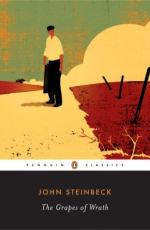|
This section contains 6,451 words (approx. 22 pages at 300 words per page) |

|
SOURCE: "American Folklife And 'The Grapes of Wrath'," in Journal of American Culture, Vol. 1, No. 4, Winter, 1978, pp. 742-53.
In the following essay, Mullen identifies a variety of folk qualities in John Steinbeck's The Grapes of Wrath, varying from elements as obvious as jokes and proverbs to ones as seemingly obscure as the physical stance of characters when conversing.
John Steinbeck's The Grapes of Wrath has been continuously popular since it was first published in 1939. Although some literary critics dismiss it, the novel remains a unique American social document which strikes a responsive chord in succeeding generations of American readers. One of the reasons for the novel's success, I think, is Steinbeck's ability to incorporate rural southwestern American folklore and folklife into the fabric of his fiction. He is able to use his own observations of folklife to develop character, give a sense of everyday life, and express the...
|
This section contains 6,451 words (approx. 22 pages at 300 words per page) |

|


